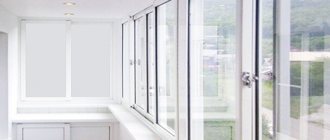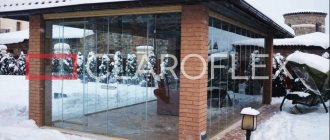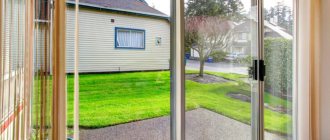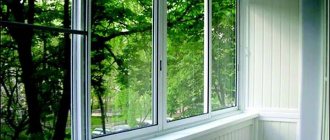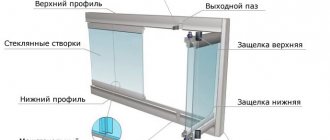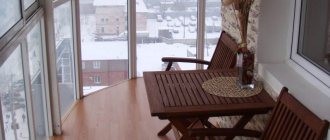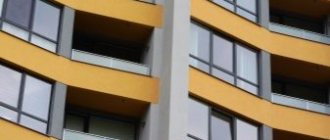Five yeses to this option
Aluminum profile is an effective way to protect against precipitation and dust
- The light weight of the aluminum structure eliminates the additional, often unsafe load on the building's floor. Therefore, if the architect is categorically against PVC and opts for this option, do not contradict!
- Good lighting due to the large area of glass and the small thickness of the frames.
- The strength, durability and fire resistance of aluminum are beyond doubt.
- Opportunity to save.
- Elegant appearance.
You can save space by installing practical sliding doors on roller mechanisms.
But neither they nor the felt seal around the perimeter, which is used every now and then for the purpose of insulation, will make the room comfortable, but will provide a temperature there in winter that is only a few degrees higher than outside the window. Is it possible to solve the problem of heat loss with little effort? It is, of course, possible to solve it, but with “little blood” it is unlikely. Both additional thermal insulation materials and heaters will require financial investments and still will not give the desired effect. Therefore, if your priority is to turn square meters into a full-fledged warm room, you will have to abandon cold glazing. But there is good news: temperature is the only reason that can stop you, because in all other cases there are practically no restrictions!
How not to make a mistake in choosing?
To choose the optimal glazing method, you need to answer a number of questions:
- Does the apartment need additional noise protection? This is a pressing problem for houses located near busy roads, airports, and railway lines;
- Is the microclimate at home comfortable? Are there any drafts?
- Do you need additional living space or additional premises?
- What is the humidity level in the apartment? Is there condensation on the windows? Are mold spots forming on the walls?
- Is the strength of the load-bearing structures of the balcony sufficient?
If the answers to the above questions are positive, then the answer is clear - warm glazing is necessary. If you plan to use the balcony for drying clothes or storing things, then you can limit yourself to cold technology.
Regardless of the chosen method, you need to correctly determine the design details and the method of opening the valves. For example, in the case of a warm balcony, the optimal combination of fixed windows with hinged sashes provides maximum sealing density. For the cold method, sliding doors are best suited, they are convenient and durable.
Warm glazing: when it’s possible and when it’s not
Do you dream of growing plants on your balcony?
Consider the option of warm glazing On one side of the scale is a significant financial investment in the installation of PVC profiles and high-quality double-glazed windows, in additional insulation and interior wall decoration. On the other is a room that will have a pleasant temperature all year round. It is this approach that allows you to turn a standard loggia, for example, into a comfortable playroom, and a small balcony into a work office. If you had the desire, the required amount - that’s all?
It turns out that persistence and money alone are sometimes not enough: not all modern buildings, unfortunately, are able to withstand the heavy weight of PVC structures. In some cases, the balcony can be strengthened before installation, but it also happens that the architects’ decision sounds like a sentence: only aluminum!
To reduce the risk of collapse to zero, a series of measurements and calculations are carried out before installation, based on the results of which a decision is made on the possibility of using a PVC profile. Despite the fact that in the modern world ways have long been invented to circumvent any prohibitions, the technical component in this case cannot be neglected: we are talking about security.
Non-standard projects
This category includes semicircular, round, polygonal structures and balconies with extensions. The arrangement of excessively long or narrow rooms can also be called non-standard, but their glazing is not much different from the usual.
Round and semicircular balconies are glazed in one of three ways: chord, bay or radius.
- Chordata. The perimeter semicircle is filled in sectors with straight frames, resulting in a somewhat angular structure. This option is the easiest to implement and the cheapest, but it does not look the best and is characterized by low energy-saving qualities.
- Bay window. The glass in this case is also flat, but a special semicircular profile is used, thanks to which the angles between the sectors are smoothed and the structure is more rigid. Bay balconies are more expensive than chord balconies, but they are warmer and more reliable.
- Radial. The most expensive and high-quality option. The profile goes around the contour of the fence, completely repeating its shape. The designs use special glass with good sound and heat insulation; panoramic implementation is possible without vertical profiles.
Glazing of polygonal individual projects or balconies in buildings of the p-44 series technically differs little from the arrangement of conventional straight or U-shaped structures.
Removable balconies
This option is relevant if the initial area of the glazed room seems insufficient. It is unlikely that it will be possible to increase the dimensions of the bottom slab, but making the glazing perimeter larger is a completely feasible task. We will use this method only for balconies with fencing, since its upper part increases.
Brackets are attached to the top of the fence, along the entire perimeter or only on one side, protruding 15-30 cm beyond the load-bearing slab. The frames are installed along the outer edge, and the added distance is used as a place for a wide window sill that hides the structure from the inside. From the outside, the brackets are covered with sheet materials, plastic lining or siding. Any balcony can be expanded in this way without coordination with utility services, if the extension does not exceed 30 cm.
About choosing glazing for a balcony - in the following video:
Subscribe
Five arguments in favor of this option
- The hermetically sealed profile and glass structure provides a high level of thermal insulation. Heat loss will be minimized, especially if all the necessary procedures for insulating the remaining surfaces are carried out.
- Compared to aluminum, plastic provides better protection against external noise. Therefore, this option is recommended if you need to glaze a loggia facing a major highway.
- The service life of PVC structures is in no way inferior to aluminum ones: the strength of the material cannot be denied.
- Also attractive is the opportunity to install different options for sashes (from standard rotary to practical parallel-sliding ones) and double-glazed windows with different numbers of chambers.
- Warm glazing allows you to create a design in a single style, for example, by decorating walls, painting profiles, selecting curtains or blinds. After all, finishing surfaces is an obligatory final stage in this process, and it would be a sin not to use such opportunities.
Classification of glazing of balconies and loggias depending on the material
Both warm and cold structures can be made of PVC profile, aluminum, wood or a combination of some of these materials.
Metal-plastic glazing
Now this is the most common and affordable option. Features of PVC windows:
- The supporting frame and opening elements (sashes) are made of a multi-chamber plastic profile, reinforced with a reinforcing insert. Warm products have up to 7 chambers and are partially filled with thermal insulating polymer. The outer walls of the profile are made up to 3 mm thick, the internal partitions are 1 mm thick.
- The structure includes either double-glazed windows or opaque filling (sandwich panels). Depending on the brand of the profile system, a double-glazed window with a depth of more than 40 mm can be installed in it. Warm products are equipped with two-chamber (3 sheets, 2 chambers) double-glazed windows. To increase the sound-absorbing effect, glass of different thicknesses is used, and the size of the chambers is also different.
Energy efficiency is improved by filling the chambers with inert gas and using special glasses or coatings for them. - The junction of the frame to the glass unit and the sash to the frame is sealed with elastic bands, thanks to which it is possible to achieve high tightness of the structure. This point should be taken into account during installation, since the flow of air into the room will only be possible when the windows are open. Typically, additional ventilation (supply valves) is installed to ensure the necessary circulation.
- The most popular color is white. This profile is usually cheaper, looks good and is easy to maintain. Other colors are also available: the profile plastic is either painted by adding pigment to the polymer or laminated with a textured film. Both options are characterized by excellent performance and appearance. The film most often imitates valuable types of wood (a common option is oak), and does not fade or peel for the entire service life of the structure.
Have you chosen a PVC profile? Be prepared for:
- Tangible costs, regardless of the manufacturer and glass unit.
- A slight reduction in usable area, especially if bulk insulation is used.
- Reduced luminous flux due to massive metal-plastic frames.
As for the last factor, only a professional will notice the difference “before” and “after” with the naked eye. In addition, you can always make adjustments using a good lighting device.
Reducing the usable area is also not a critical factor: a couple of centimeters used around the perimeter will not exclude the possibility of placing a coffee table, flower pots, etc. on the loggia - everything that was originally planned. But as for investments, alas, you can’t live without them, no matter what option you choose! But, on the other hand, “buying” a full-fledged, albeit small in area, warm room (for example, through an apartment with many rooms) will cost many times more than insulating a balcony or loggia.
